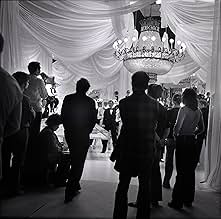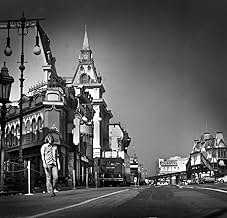IMDb-BEWERTUNG
6,4/10
1369
IHRE BEWERTUNG
Füge eine Handlung in deiner Sprache hinzuThree movie genres of the 1930s--boxing films, World War I aviation dramas, and backstage Broadway musicals--are satirized using the same cast.Three movie genres of the 1930s--boxing films, World War I aviation dramas, and backstage Broadway musicals--are satirized using the same cast.Three movie genres of the 1930s--boxing films, World War I aviation dramas, and backstage Broadway musicals--are satirized using the same cast.
- Regie
- Drehbuch
- Hauptbesetzung
- Auszeichnungen
- 3 Gewinne & 10 Nominierungen insgesamt
Peter Stader
- Barney Keegle (segment "Dynamite Hands")
- (as Peter T. Stader)
Jimmy Lennon Sr.
- The Announcer (segment "Dynamite Hands")
- (as James Lennon)
Empfohlene Bewertungen
Just wrote a review of the far, far, far, far, inferior "National Lampoon's Movie Madness," which also parodies films, though contemporary ones. I brought up "Movie Movie" as an example of the same concept which is as excellent as the National Lampoon movie is awful.
This is a delightful trip back to the movies of the 1930's. Somehow I saw this movie when it first came out. I guess I sought it out as (having been an eager consumer of Mad Magazine as a little squirt) I am a fan of parodies and mockumentaries of this sort. I remember watching it in a tiny closet-sized movie theater in a shopping mall in New Jersey. I wouldn't be surprised if it was the only movie theater in the state of New Jersey that played it. I was only 12 years old at the time, and obviously not around during the 1930's, but I had been exposed to enough old movies on television during my young life that I enjoyed the whole thing fully.
I remember noticing that both movies start off with the same stock footage of a busy Manhattan street, the first one in black and white of course, and the second one in color, both backed by a similar jaunty tune meant to evoke the bustle of Manhattan in the 1930's. Sure to provoke a big laugh even before we meet the characters or hear the first line of dialog.
Who know George C. Scott had such a facility for comedy? It's worth finding out. If you are in any way, shape or form a fan of crusty old movies, you should seek this out. A lovable way to spend 100 minutes.
This is a delightful trip back to the movies of the 1930's. Somehow I saw this movie when it first came out. I guess I sought it out as (having been an eager consumer of Mad Magazine as a little squirt) I am a fan of parodies and mockumentaries of this sort. I remember watching it in a tiny closet-sized movie theater in a shopping mall in New Jersey. I wouldn't be surprised if it was the only movie theater in the state of New Jersey that played it. I was only 12 years old at the time, and obviously not around during the 1930's, but I had been exposed to enough old movies on television during my young life that I enjoyed the whole thing fully.
I remember noticing that both movies start off with the same stock footage of a busy Manhattan street, the first one in black and white of course, and the second one in color, both backed by a similar jaunty tune meant to evoke the bustle of Manhattan in the 1930's. Sure to provoke a big laugh even before we meet the characters or hear the first line of dialog.
Who know George C. Scott had such a facility for comedy? It's worth finding out. If you are in any way, shape or form a fan of crusty old movies, you should seek this out. A lovable way to spend 100 minutes.
I viewed this movie in Israel, where it was shown with subtiles. Whilst discusing the movie what stood out was how those who had relied only on the text viewed it as a serious presentation exactly as the style/era that it was spofing. Contrast this with native English speakers, who also were familiar with the era could detect the various sendups and would frequently burst out in peals of laughter. All in all I found it very well presented and acted, well worth viewing both for it's content and social comment.
Stanley Donen in 1978 was old enough to remember how Warner Brothers double features of the 1930s played, and he brings them pretty gloriously back to life in this affectionate double-bill-within-a-single-movie, helped by a knowing, funny script by Larry Gelbart and Sheldon Keller. The first, a Kid Galahad-type boxing melo reveling in bad Clifford Odets-style metaphors, looks wonderful in black and white and is superbly cast, with, among others, George C. Scott in what might have been the Walter Huston role, Red Buttons doing Frank McHugh, Harry Hamlin as Wayne Morris, and a very funny Trish van Devere lampooning Eva Marie Saint in On the Waterfront. The 42nd Street parody rounding it out has some curiosities--it's in color, which it wouldn't have been in in 1933, the songs aren't all diegetic as they would have been, the camera work's a little more sophisticated than it should be--but gets most of it right, including Barry Bostwick and Rebecca York doing Dick Powell and Ruby Keeler and Barbara Harris doing a Joan Blondell. The in-between preview, Zero Hour--War at Its Best!--is a riot, with Scott, Buttons, and Eli Wallach parading around as some hilariously overage young World War I fliers. This didn't make much noise in 1978, and it's hard to know why--it's marvelously entertaining, the cast is aces, and plenty of people around then remembered the originals it so expertly spoofs.
A quick glance at the user comments will tell you that this film is worth seeing. I'm neither a musical fanatic nor a boxing enthusiast, but the numbers, performances and nuances were entrancing.
Somehow, Donen found the perfect blend for the self-reflexive genre picture, a combination that is exceedingly difficult for modern filmmakers to get a handle on. The viewer is watching a spoof yet all of the elements are still real. We feel for the pitifully archetypal characters because it seems that they realize their fate as symbols. George C. Scott's glances of reaction, just askew of breaking the third wall, depict someone who is aware of his limited fate, but still experiences with all of his emotions every situation as if he doesn't know it's coming. In this way, the actors, as in the Brechtian mode of theater, are somewhat like audience members themselves. They know the story and the ending, but they can't help suspending their disbelief, just for fun.
The musical numbers work in the same way. They are spoofs, fulfilling specific purposes and making all the proper illusions, yet are thoroughly enjoyable as musical numbers.
"Movie Movie" isn't necessarily a great movie, but it gives the illusion of greatness in its sincerity. In a medium where the audience often feels that they are the butt of a joke only the director knows the setup to, "Movie Movie" puts across the feeling that the director genuinely enjoys movies and expects everyone involved to derive the same pleasure from them.
Somehow, Donen found the perfect blend for the self-reflexive genre picture, a combination that is exceedingly difficult for modern filmmakers to get a handle on. The viewer is watching a spoof yet all of the elements are still real. We feel for the pitifully archetypal characters because it seems that they realize their fate as symbols. George C. Scott's glances of reaction, just askew of breaking the third wall, depict someone who is aware of his limited fate, but still experiences with all of his emotions every situation as if he doesn't know it's coming. In this way, the actors, as in the Brechtian mode of theater, are somewhat like audience members themselves. They know the story and the ending, but they can't help suspending their disbelief, just for fun.
The musical numbers work in the same way. They are spoofs, fulfilling specific purposes and making all the proper illusions, yet are thoroughly enjoyable as musical numbers.
"Movie Movie" isn't necessarily a great movie, but it gives the illusion of greatness in its sincerity. In a medium where the audience often feels that they are the butt of a joke only the director knows the setup to, "Movie Movie" puts across the feeling that the director genuinely enjoys movies and expects everyone involved to derive the same pleasure from them.
MOVIE, MOVIE is a forgotten gem from the late 70's which is an affectionate spoof of a 1930's double feature (there's even a preview of coming attractions)that is divided into two separate films that run about 50 minutes a piece. The first film, "Dynamite Hands" is a black and white "Golden Boy"-type spoof with Harry Hamlin as a young boxer rising to the top with George C. Scott as his manager, Red Buttons as his trainer, Kathleen Beller as his hometown girlfriend and Ann Reinking as a nightclub singer named Troubles Moran. The second film is called "Baxter's Beauties of 1933" and is a colorful spoof of films like 42nd STREET with George C. Scott featured again as the egomaniacal director, Barry Bostwick as the idealistic young songwriter, Rebecca York (who years later would practically steal the Broadway show VICTOR/VICTORIA from Julie Andrews) as the young Ruby Keeler type and Trish VanDevere as the bitchy diva who York eventually replaces. True movie buffs and fans of these kinds of movies will be in cinema heaven here...a loving tribute to a bygone era that works thanks to spirited direction by Stanley Donen and an energetic cast.
Wusstest du schon
- WissenswertesIn the original theatrical release, "Dynamite Hands" which was filmed in color, was printed in black and white. The home video version uses the original color footage. Contrary to rumors, the video version was not colorized.
- PatzerAssuming Baxter's Beauties of 1933 had actually been shot in 1933, it would have used two-strip Technicolor, also known as Red Technicolor because it is particularly good at photographing the red spectrum. This is shot in the three-strip process, or Blue Technicolor, which would not be introduced until 1935. Additionally, most musicals would not be shot completely in color until the 1940s.
- Zitate
Joey Popchik: When a man says what's right, what's good, what's real, and what's true, then his mouth is ten feet tall.
- Crazy CreditsThe cast list in the closing credits is divided into two sections with headings Dynamite Hands and Baxter's Beauties of 1933.
- Alternative VersionenIn the theatrical and pay-tv release, the first half of "Movie, Movie" is in black and white, while both halves are often shown in color in commercial TV.
- SoundtracksOverture to Baxter's Beauties of 1933
Music by Ralph Burns and Buster Davis
Performed by Ralph Burns and the Orchestra
Top-Auswahl
Melde dich zum Bewerten an und greife auf die Watchlist für personalisierte Empfehlungen zu.
- How long is Movie Movie?Powered by Alexa
Details
- Erscheinungsdatum
- Herkunftsländer
- Sprache
- Auch bekannt als
- Double Feature
- Drehorte
- Produktionsfirma
- Weitere beteiligte Unternehmen bei IMDbPro anzeigen
Box Office
- Budget
- 6.000.000 $ (geschätzt)
- Laufzeit
- 1 Std. 45 Min.(105 min)
- Farbe
- Sound-Mix
- Seitenverhältnis
- 1.85 : 1
Zu dieser Seite beitragen
Bearbeitung vorschlagen oder fehlenden Inhalt hinzufügen





































